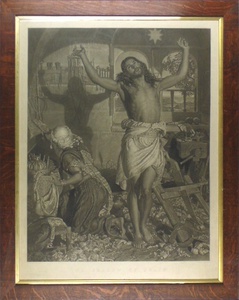| Method | Mezzotint & Etching |
| Artist | Frederick Stacpoole after William Holman Hunt |
| Published | London Published May 30th 1878 by Thomas Agnew & Sons, the proprietors, Old Bond Street. Copyright Registered. Entered accroding to Act of Congress in the year 1878 by William Schaus, 749 Broadway New York, in the office of the Librarian of Congress, Washington |
| Dimensions | Image 740 x 570 mm |
| Notes |
Holman Hunt worked on The Shadow of Death between the years of 1870-1873, during his second excursion to the Holy Land. A masterpiece of the Pre-Raphaelite canon, Holman Hunt's depiction of Christ is arguably the greatest example of typological symbolism that any of the Brotherhood would produce. Championed by John Ruskin in the second volume of Modern Painters, typological symbolism was a method that combined heightened verisimilitude with elaborate iconography, and became central to the core of Pre-Raphaelite theory. In Hunt's work, as in Stacpoole's print, the outstretched arms of Jesus cast a shadow upon the wooden tool rack on the wall behind him. Thus, Christ's crucifixion is prefigured within the natural setting of the workshop. Furthermore, the tools become types of those used to torture Jesus, whilst the shadow of the saw appears like the spear that was used to pierce his side. Examples of other details that function as types can be found in the window above Christ's left shoulder which alludes to the star of Bethlehem, and the gap directly behind his head which forms a halo. Stacpoole began work on The Shadow of Death in 1874. The original picture had been bought by Thomas Agnew & Sons and was exhibited so widely that, on publication of the engravings in 1877, the sale of proofs alone realised more than £20,000. Frederic Stacpoole (1813 - 1907) was an English engraver who worked in the mixed mezzotint method. He was educated in Ghent, Belgium, and later at the Royal Academy Schools, London, where he was awarded silver medals in 1839 and 1841. He later became an associate Royal Academician. Of Stacpoole's many plates, perhaps the most celebrated are those after William Holman Hunt's The Shadow of Death or the militaristic subjects of Elizabeth Thompson. William Holman Hunt (1827 - 1910) was a Victorian painter, etcher and watercolourist. He entered the Royal Academy Schools in 1844 where he met John Everett Millais, who was to become his closest friend. He was a founding member of the Pre-Raphaelite Brotherhood and adhered to their principles throughout a long career in the arts. From the 1870's onwards, Hunt concentrated on religious themes informed by successive visits to the Holy Land. He was not the first nineteenth-century artist to journey to the East; David Wilkie and David Roberts were but a few that had gone before him. He was however the first to depict the land with such imaginative grandeur and minute detailing. He published his autobiographical Pre-Raphaelitism and the Pre-Raphaelite Brotherhood in 1905. Ex. Col.: Hon. Christopher Lennox -Boyd. Condition: Small crease in right and some light surface toning. In a contemporary frame. |
| Framing | framed |
| Price | £1,500.00 |
| Stock ID | 37037 |

